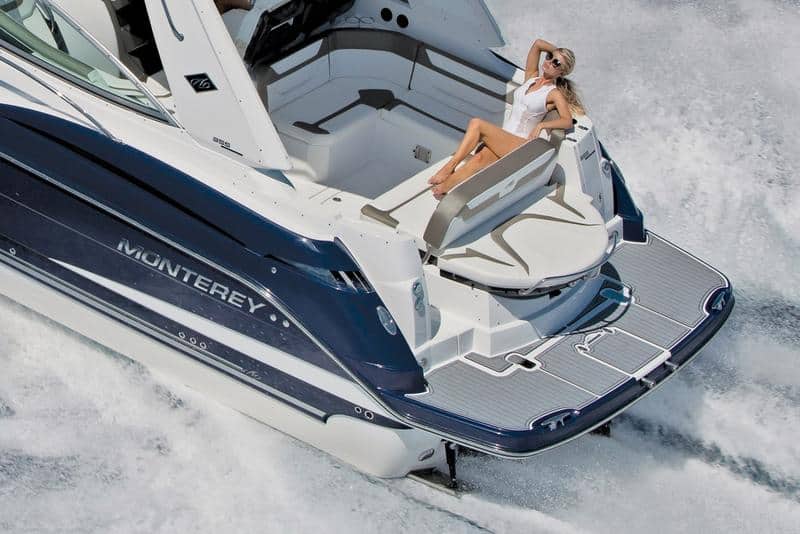Understanding Trim Tabs
Trim tabs are two independently adjustable metal plates controlled by a panel at the helm. These tabs can help compensate for engine torque or unequal weight distribution. What do trim tabs do on a boat? They give you the ability to trim the hull and the prop independently and to make lateral adjustments to avoid sideways list. Since the trim tabs can take over trimming the hull, the power trim can focus solely on adjusting the prop. By having the power trim and trim tabs work together, your boat achieves optimum performance and efficiency you can’t get with the power trim alone.
How Do Trim Tabs Work?
These tabs are mounted on either side of the transom of the boat. They are completely independent of one another — not connected to each other. When you’re focused on adjusting the power trim of the boat, you now have two additional metal plates you can use to do the heavy lifting when it comes to tilting the engine in or out. In this case, you’d have both metal plates tilted about the same angle in or out, to match the power trim of the engine. This alleviates some of the work on the prop and helps you maximize performance.
Dealing with Boat Lean
But what happens when you start to notice the boat leaning? Without trim tabs, there isn’t much you can do besides moving passengers and cargo or adjusting your speed and route. Fortunately, you can adjust each of the trim tabs independently and can easily compensate for a shift in sea conditions, weather, etc., without having to make adjustments in weight distribution or changing your route.
Tips for Using Your Monterey Boat’s Trim
- Distribute Weight Evenly:
Before you leave the dock, check to make sure the weight of the boat is distributed evenly, so it sits evenly in the water. Even though you can use power trim and trim tabs to compensate for uneven weight, it’s ideal to begin with distributing weight as evenly as possible. - Use Your Power Trim and Trim Tabs as a Team:
Remember to use the power trim to adjust the prop path parallel to the water flow. Use trim tabs to trim the hull of the boat — both up and down and from side to side. When you use the two of them together, each controlling their part of the trimming process, you maximize your boat’s performance. - Start with Trim Down:
When you’re taking off from displacement speeds, most boats work best with the engine and bow trimmed down — this helps the boat rise quickly onto the plane. However, once your boat is on plane, it’s important to adjust the trim based on the sea conditions. - Monitor Speed, RPMs, and Propeller as You Trim:
Pay attention to your speed, RPMs, and propeller ventilation, as these three are key to knowing when your boat is properly trimmed and running at maximum efficiency. Trimming up will eventually trigger a slight drop in speed, a sharp rise in RPMs, and/or propeller ventilation — at this point, you’ve trimmed up too far. Begin trimming down in small increments to reach your maximum speed, consistent RPMs, or lack of propeller ventilation, and you’ll strike a balance for proper trim. - Bow Spray, Stern Wake, and Rooster Tail Can Help You Trim:
If you’re steering your boat from a bridge or tower, observe characteristics related to spray and wake that can help you find your boat’s ideal trim. If you see more spray toward the stern of the boat and a larger wake, the boat’s trim can be better. When your boat is reaching its proper trim, you’ll notice the bow spray is farther forward, the wake is smaller, and the rooster tail is also smaller and farther behind your boat. - Keep Trim Adjustments Small:
Adjust your trim tabs using short, half-second bursts — followed by a pause to let the boat react — before making another adjustment. Be patient as each boat may respond differently based on the size of your trim tabs and your boat’s speed. - Do Not Over-Trim:
Ensure you do not deflect the trim tabs too far, especially at high speeds. Extreme changes to the angle of the bow on the move, combined with sea conditions, can cause the boat to veer. Avoid moving one trim tab significantly lower than the other, as this may cause the boat to lean suddenly to one side. - Be Aware of Trim’s Effect on Your Wake:
Trim settings will change the size of your wake. Trim down to minimize your wake in a slow or no-wake zone. However, for a better wake for waterskiing or wakeboarding, trim up while adding speed to see a rooster tail. - Use Your Trim as a Turning Tool:
When you enter a turn, begin trimming down — the more down trim, the more you can accelerate through a turn. In the sharpest part of the turn, you should have maximum down trim based on speed and radius. As the boat slows, add throttle and begin to trim up as you straighten the wheel. - Occasionally Check Your Trim Tabs:
As with any part of a boat, trim tabs can have loose or corroded wires over time. Inspect them visually to ensure they are not in need of repair. Malfunction or failure of trim tabs can be dangerous.









